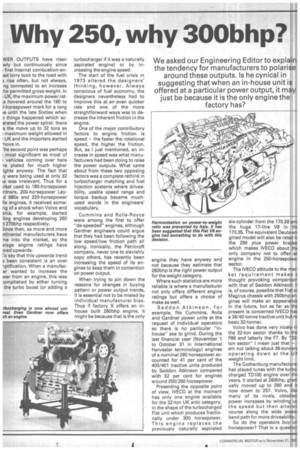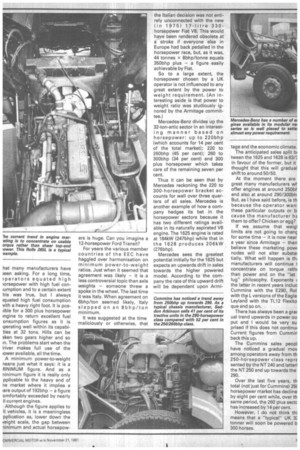Why 250, why 300bhp?
Page 42

Page 43

If you've noticed an error in this article please click here to report it so we can fix it.
We asked our Engineering Editor to explain the tendency for manufacturers to polarise around these outputs. Is he cynical in suggesting that when an in-house unit is offered at a particular power output, it may just be because it is the only engine the factory has?
WER OUTPUTS have risen wly but continuously since first internal combustion-en:ed lorry took to the road with 5 rise often, but not always, ng connected to an increase he permitted gross weight. In : UK, the maximum power rat:s hovered around the 180 to )-horsepower mark for a long le until the late Sixties when 3 things happened which acerated the power spiral: there s the move up to 32 tons as maximum weight allowed in UK and the importers started move in.
The second point was perhaps most significant as most of vehicles coming over here re plated for much higher ights anyway. The fact that :y were being used at only 32 is was irrelevant. Thus for a irket used to 1E30-horsepower rdners, 200-horsepower Leyd 680s and 220-horsepower Ils engines, it received someng of a shock when Volvo and 3nia, for example, started ling engines developing 260 270bhp respectively.
;ince then, as more and more ntinental manufacturers have .ne into the market, so the ?rage engine ratings have sved upwards.
ro say that this upwards trend s been consistent is an over iplification. When a manufacer wanted to increase the wer from an engine, this was omplished by either turning the turbo boost (or adding a turbocharger if it was a naturally aspirated engine) or by increasing the engine speed.
The start of the fuel crisis in 1973 altered the designers' thinking, however. Always conscious of fuel economy, the designers nevertheless had to improve this at an even quicker rate and one of the more straightforward ways was to decrease the inherent friction in the engine.
One of the major contributory factors to engine friction is speed — the faster the rotational speed, the higher the friction. But, as I just mentioned, an increase in speed was what manufacturers had been doing to raise the power outputs. What came about from these two opposing factors was a complete rethink in turbocharger matching and fuel injection systems where driveability, usable speed range and torque backup became muchused words in the engineers' vocabulary.
Cummins and Rolls-Royce were among the first to offer "de-speeded" engines, although Gardner engineers could argue that they had been following the low speed/low friction path all along. Ironically, the Patricroft company, never one to slavishly copy others, has recently been increasing the speed of its engines to keep them in contention on power output.
When trying to pin down the reasons for changes in buying pattern or power output trends, it is essential not to be misled by individual manufacturer bias. Thus if factory X offers an inhouse built 280bhp engine, it might be because that is the only engine they have anyway and not because they estimate that 280bhp is the right power output for the weight category.
Where such statistics are more reliable is where a manufacturer not only offers different engine ratings but offers a choice of make as well.
Seddon Atkinson, for example, fits Cummins, Rolls and Gardner power units at the request of individual operators so there is no particular "inhouse" axe to grind. During the last financial year (November 1 to October 31 in International Harvester terminology) engines of a nominal 290 horsepower accounted for 41 per cent of the 400/401 tractive units produced by Seddon Atkinson compared with 52 per cent for engines around 250/260 horsepower.
Presenting the opposite point of view. IVECO at the moment has only one engine available for the 32-ton UK artic category, in the shape of the turbocharged Fiat unit which produces fractionally under 300 horsepower. This engine replaces the previously naturally aspirated six-cylinder from the 170.26 an the huge 17-litre V8 in VII 170.35. The equivalent Deutz-err gined model will also be rated ir the 290 plus power bracke which makes IVECO about thi only company not to offer at engine in the 250-horsepowei sector.
The IVECO attitude to the mat+ ket requirement makes el thought provoking comparisor with that of Seddon Atkinson. Ii is, of course, possible that Fiat Qi Magirus chassis with 250bhp en. gines will make an appearance in the future, but as far as the present is concerned IVECO her. a 38/40-tonne tractive unit but nc basic 32-tonner.
Volvo has done very nicely ir the 32-ton sector thanks to the F86 and latterly the F7. By "32. ton sector" I mean just that — I am not talking about 38-tonnere operating down at the U14 weight limit.
The Gothenburg manufacture: has played tunes with the turbo. charged TD100 engine over the years. It started at 260bhp, grad. ually moved up to 290 and now down to 257. Volvo, like many of its rivals, obtainec power increases by winding ur the speed but then alterec course along the wide powei band path for more driveability.
So do the operators buy or horsepower? That is a questior hat many manufacturers have )een asking. For a long time, )perators equated high lorsepower with high fuel con;umption and to a certain extent his was true, but I always :quated high fuel consumption vith a heavy right foot. It is posMole for a 300 plus horsepower :ngine to return excellent fuel onsumption figures as it is ;perating well within its capabities at 32 tons. Hills can be aken two gears higher and so in. The problems start when the !river makes full use of the lower available, all the time.
A minimum power-to-weight leans just what it says: it is a /IINIMUM figure. And as a ninimum figure it is really only pplicable to the heavy end of ne market where it implies a rare output of 192bhp — a figure omfortably exceeded by nearly II current engines.
Although the figure applies to II vehicles, it is a meaningless pplication as, lower down the veight scale, the gap between ninimum and actual horsepow
ers is huge. Can you imagine a 12-horsepower Ford Transit?
For years the various member countries of the EEC have haggled over harmonisation on minimum power-to-weight ratios. Just when it seemed that agreement was likely — it is •a less controversial topic than axle weights — someone threw a spoke in the wheel. The last time it was Italy. When agreement on 6bhp/ton seemed likely, Italy slapped on an 8 bhp/ton minimum.
It was suggested at the time maliciously or otherwise, that the Italian decision was not entirely unconnected with the new (in 1975) 17-litre 330horsepower Fiat V8. This would have been rendered obsolete at a stroke if everyone else in Europe had back pedalled in the horsepower race, but, as it was, 44 tonnes x 8bhp/tonne equals 350bhp plus — a figure easily achievable by Fiat.
So to a large extent, the horsepower chosen by a UK operator is not influenced to any great extent by the power to weight requirement. (An interesting aside is that power to weight ratio was studiously ignored by the Armitage committee.) Mercedes-Benz divides up the 32-ton-artic sector in an interesting manner based on horsepower: up to 220bhp (which accounts for 14 per cent of the total market); 220 to 260bhp (45 per cent); 260 to 300bhp (34 per cent) and 300 plus horsepower which takes care of the remaining seven per cent.
Thus it can be seen that by Mercedes reckoning the 220 to 300-horsepower bracket accounts for well over three quarters of all sales. Mercedes is another example of how a company hedges its bet in the horsepower sectors because it has two different ratings available in its naturally aspirated V8 engine. The 1625 engine is rated at 184kW (247bhp) while that in the 1628 produces 206kW (276bhp).
Mercedes sees the greatest potential initially for the 1625 but expects an upwards drift in sales towards the higher powered model. According to the company the rate of this upward drift will be dependent upon Armi
tage and the economic climate. The anticipated sales split in; .tween the 1625 and 1628 is 63/:: in favour of the former, but it thought that this will gradual shift to around 50/50.
At the moment there are great many manufacturers offer engines at around 250b1and also at around 290/300bh But, as I have said before, is th because the operator wan• these particular outputs or lp cause the manufacturer hz them to offer? Chicken or egg?
If we assume that weigl limits are not going to chanc for some time — it is now near a year since Armitage — then believe these marketing pow( nodes will not alter substa: tially. What will happen is th; manufacturers will continue I concentrate on torque rath( than power and on the "let lug" philosophy. Exponents ( the latter in recent years inclue Cummins with the E290, Rol with the L versions of the Eagle: Leyland with the TL12 Flexito que and so on.
There has always been a gra( ual trend upwards in power ou put and I would be very su prised if this does not continui Current figures from Cummin back this up.
The Cummins sales peopl have noticed a gradual mov among operators away from th 250-horsepower class reprE sented by the NT 240 and latterl the NT 250 and up towards the 290.
Over the last five years, th total (not just for Cummins) 25( horsepower market has decline by eight per cent while, over th same period, the 260 plus sectc has increased by 14 per cent.
However, I do not think thi means that a "typical" UK tonner will soon be powered b 300 horses.


















































